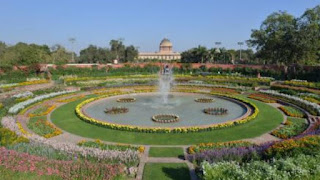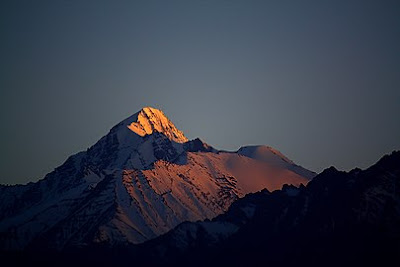MUGHAL GARDEN, RASHTRAPATI BHAVAN, NEW DELHI
INTRODUCTION: Sir Edwin
Lutyens had finalized the designs of the Mughal
Gardens as early as 1917, however it was only during the year 1928-1929
that plantings were done. His collaborators for the gardens was Director of
Horticulture, William Mustoe. Sir Lutyens brought together two different
horticulture traditions together for the gardens, the Mughal style and the English flower garden. Mughal
canals , terraces and flowering shrubs are beautifully blended with European flowerbeds, lawns and private hedges.
Sir Edwin
Lutyens had finalized the designs of the Mughal
Gardens as early as 1917, however it was only during the year 1928-1929
that plantings were done. His collaborators for the gardens was Director of
Horticulture, William Mustoe. Sir Lutyens brought together two different
horticulture traditions together for the gardens, the Mughal style and the English flower garden. Mughal
canals , terraces and flowering shrubs are beautifully blended with European flowerbeds, lawns and private hedges.
MAJOR ATTRACTIONS: Rose remains
a key feature of the Mughal Gardens even today. The gardens boasts of growing
159 celebrated varieties of roses which blossom primarily in the month of February
and March. They include, Adora, Mrinalini, Taj Mahal, Eiffel Tower,
Modern Art, Scentimental, Oklahoma (also called black rose), Belami,
Black Lady, Paradise, Blue Moon and Lady X. The
Mughal Gardens also include roses named after people of national and
international fame such as Mother Teresa, Raja Ram Mohan Roy, Mr.
Lincoln, John F. Kennedy, Jawahar, Queen Elizabeth, Christian Dioramongst
others. Arjun and Bhim, from the Mahabharata, also
find place in the presidential palace.
Rose remains
a key feature of the Mughal Gardens even today. The gardens boasts of growing
159 celebrated varieties of roses which blossom primarily in the month of February
and March. They include, Adora, Mrinalini, Taj Mahal, Eiffel Tower,
Modern Art, Scentimental, Oklahoma (also called black rose), Belami,
Black Lady, Paradise, Blue Moon and Lady X. The
Mughal Gardens also include roses named after people of national and
international fame such as Mother Teresa, Raja Ram Mohan Roy, Mr.
Lincoln, John F. Kennedy, Jawahar, Queen Elizabeth, Christian Dioramongst
others. Arjun and Bhim, from the Mahabharata, also
find place in the presidential palace.
Apart from
roses, tulips, Asiatic lilies, daffodils, hyacinth and other seasonal flowers beautify the gardens of Rashtrapati Bhavan, There are more than seventy
varieties of seasonal flowers including
exotic bulbous and winter flowering plants. The gardens also grows 60 of the
101 known types of bougainvilleas. Edging and flowering of flower beds is done
with alyssum, daisy, pansy etc. The grass that covers the garden is the doob
grass, which was originally brought from
Calcutta when the Mughal Garden was being planted. The garden has almost 50
varieties of trees, shrubs and vines including Moulsiri tree, Golden Rain tree,
flower bearing Torch Tree and many more.
In fact,
this is the place which everyone must
visit at least once. I hope this will make you feel that nature is very
beautiful if you want to enjoy it.
 Sir Edwin
Lutyens had finalized the designs of the Mughal
Gardens as early as 1917, however it was only during the year 1928-1929
that plantings were done. His collaborators for the gardens was Director of
Horticulture, William Mustoe. Sir Lutyens brought together two different
horticulture traditions together for the gardens, the Mughal style and the English flower garden. Mughal
canals , terraces and flowering shrubs are beautifully blended with European flowerbeds, lawns and private hedges.
Sir Edwin
Lutyens had finalized the designs of the Mughal
Gardens as early as 1917, however it was only during the year 1928-1929
that plantings were done. His collaborators for the gardens was Director of
Horticulture, William Mustoe. Sir Lutyens brought together two different
horticulture traditions together for the gardens, the Mughal style and the English flower garden. Mughal
canals , terraces and flowering shrubs are beautifully blended with European flowerbeds, lawns and private hedges. Rose remains
a key feature of the Mughal Gardens even today. The gardens boasts of growing
159 celebrated varieties of roses which blossom primarily in the month of February
and March. They include, Adora, Mrinalini, Taj Mahal, Eiffel Tower,
Modern Art, Scentimental, Oklahoma (also called black rose), Belami,
Black Lady, Paradise, Blue Moon and Lady X. The
Mughal Gardens also include roses named after people of national and
international fame such as Mother Teresa, Raja Ram Mohan Roy, Mr.
Lincoln, John F. Kennedy, Jawahar, Queen Elizabeth, Christian Dioramongst
others. Arjun and Bhim, from the Mahabharata, also
find place in the presidential palace.
Rose remains
a key feature of the Mughal Gardens even today. The gardens boasts of growing
159 celebrated varieties of roses which blossom primarily in the month of February
and March. They include, Adora, Mrinalini, Taj Mahal, Eiffel Tower,
Modern Art, Scentimental, Oklahoma (also called black rose), Belami,
Black Lady, Paradise, Blue Moon and Lady X. The
Mughal Gardens also include roses named after people of national and
international fame such as Mother Teresa, Raja Ram Mohan Roy, Mr.
Lincoln, John F. Kennedy, Jawahar, Queen Elizabeth, Christian Dioramongst
others. Arjun and Bhim, from the Mahabharata, also
find place in the presidential palace.


your feedbacks may worth a lot to me.
ReplyDeleteAwesome work... Mr. Sushil Kumar
DeleteThanks bhai
DeleteThis comment has been removed by the author.
ReplyDeleteThis comment has been removed by the author.
Delete